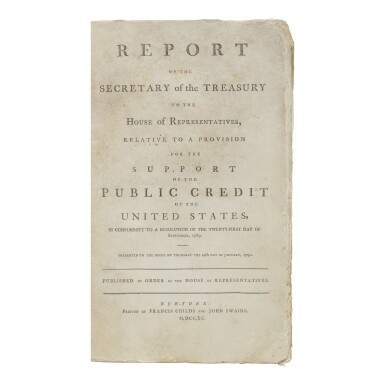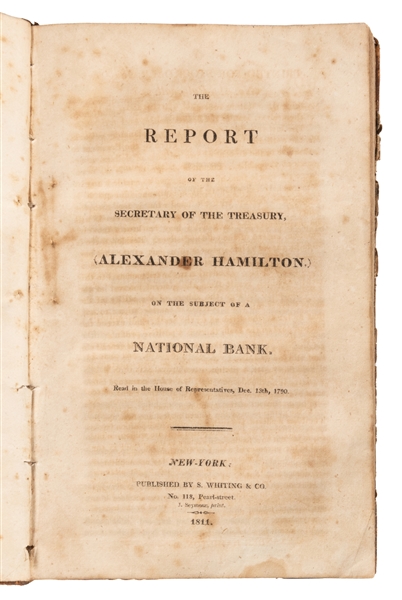HAMILTON, Alexander]. BANK OF NEW YORK. Broadside, Bank Conditions , n.d. [ca. March 1784]. New York: Samuel Loudon, No. 5 Water Street. 1 page, folio (15½ x 9 3/8in.), closed tears at creases, tack holes (from posting?) at each of the four corners, slight paper loss (away from text) at lower left .
HAMILTON, Alexander]. BANK OF NEW YORK. Broadside, Bank Conditions , n.d. [ca. March 1784]. New York: Samuel Loudon, No. 5 Water Street. 1 page, folio (15½ x 9 3/8in.), closed tears at creases, tack holes (from posting?) at each of the four corners, slight paper loss (away from text) at lower left . HAMILTON'S PLAN FOR SELLING SHARES AND ELECTING DIRECTORS AND OFFICERS OF HIS NEW BANK OF NEW YORK An incredibly rare survival from a pivotal moment of American business history: a broadside publication of Hamilton's words announcing plans to create the Bank of New York: "At a Meeting of the principal Merchants and Citizens at the Coffee-House, on the 26th February, General M'Dougall in the Chair, The following proposals for the Establishment of a Bank, were read and unanimously agreed to. Article 1st. That this Bank be called by the Name and Title of, The Bank of New York. 2d. That the capital Stock consist of Five Hundred Thousand Dollars, in Gold or Silver, divided into one Thousand Shares, at Five Hundred Dollars each Share..." Once 500 shares were subscribed a meeting of stockholders would take place to devise a constitution for the Bank, elect a president, twelve directors, and a cashier. Dividends would be paid 12 months after the Bank's opening "and every six months thereafter..." Hamilton was the driving force behind this bank and author of its constitution. In fact, the Bank of New York was an attempt to head-off the creation of a so-called "land bank" by a faction of upstate gentry led by Robert Livingston. The land bank was to be capitalized with real estate mortgages, providing a capital fund for the gentry's land purchases. Hamilton shook his head at the narrow vision of these grandees--many of whom were his clients and in-laws--mocking their proposed bank as "the true philosopher's stone that was to turn all their rocks and trees into gold" (quoted in Hammond, Banks and Politics in America , 65). The thriving port of New York--an expanding source of trade and wealth for the new nation--needed a much more dynamic bank, one with a species-based capitalization that could serve a wider variety of economic needs. Hamilton and his "money bank" faction got their new institution up and running quickly. He and McDougall co-chaired the 26 February meeting; Hamilton wrote the bank's constitution sometime between 26 February and 15 March, by which time the required 500 shares were subscribed and a president and slate of directors elected. McDougall was the first president and Hamilton one of the 12 directors (as well as the Bank's counsel). His constitution also included an important change in voting privileges from what is described here, where the maximum voting right is fixed at seven votes for those holding ten shares, and "no stockholder shall have more than seven votes, be the number of his shares ever so many." Hamilton agreed to allow an extra vote for every five shares above ten, thereby giving much greater weight to large investors such as his brother-in-law John B. Church. The Bank opened for business in June, and a few years later, in 1792, became the first stock traded on the New York Stock Exchange. This broadside is exceptionally rare. Not listed in Evans.
HAMILTON, Alexander]. BANK OF NEW YORK. Broadside, Bank Conditions , n.d. [ca. March 1784]. New York: Samuel Loudon, No. 5 Water Street. 1 page, folio (15½ x 9 3/8in.), closed tears at creases, tack holes (from posting?) at each of the four corners, slight paper loss (away from text) at lower left .
HAMILTON, Alexander]. BANK OF NEW YORK. Broadside, Bank Conditions , n.d. [ca. March 1784]. New York: Samuel Loudon, No. 5 Water Street. 1 page, folio (15½ x 9 3/8in.), closed tears at creases, tack holes (from posting?) at each of the four corners, slight paper loss (away from text) at lower left . HAMILTON'S PLAN FOR SELLING SHARES AND ELECTING DIRECTORS AND OFFICERS OF HIS NEW BANK OF NEW YORK An incredibly rare survival from a pivotal moment of American business history: a broadside publication of Hamilton's words announcing plans to create the Bank of New York: "At a Meeting of the principal Merchants and Citizens at the Coffee-House, on the 26th February, General M'Dougall in the Chair, The following proposals for the Establishment of a Bank, were read and unanimously agreed to. Article 1st. That this Bank be called by the Name and Title of, The Bank of New York. 2d. That the capital Stock consist of Five Hundred Thousand Dollars, in Gold or Silver, divided into one Thousand Shares, at Five Hundred Dollars each Share..." Once 500 shares were subscribed a meeting of stockholders would take place to devise a constitution for the Bank, elect a president, twelve directors, and a cashier. Dividends would be paid 12 months after the Bank's opening "and every six months thereafter..." Hamilton was the driving force behind this bank and author of its constitution. In fact, the Bank of New York was an attempt to head-off the creation of a so-called "land bank" by a faction of upstate gentry led by Robert Livingston. The land bank was to be capitalized with real estate mortgages, providing a capital fund for the gentry's land purchases. Hamilton shook his head at the narrow vision of these grandees--many of whom were his clients and in-laws--mocking their proposed bank as "the true philosopher's stone that was to turn all their rocks and trees into gold" (quoted in Hammond, Banks and Politics in America , 65). The thriving port of New York--an expanding source of trade and wealth for the new nation--needed a much more dynamic bank, one with a species-based capitalization that could serve a wider variety of economic needs. Hamilton and his "money bank" faction got their new institution up and running quickly. He and McDougall co-chaired the 26 February meeting; Hamilton wrote the bank's constitution sometime between 26 February and 15 March, by which time the required 500 shares were subscribed and a president and slate of directors elected. McDougall was the first president and Hamilton one of the 12 directors (as well as the Bank's counsel). His constitution also included an important change in voting privileges from what is described here, where the maximum voting right is fixed at seven votes for those holding ten shares, and "no stockholder shall have more than seven votes, be the number of his shares ever so many." Hamilton agreed to allow an extra vote for every five shares above ten, thereby giving much greater weight to large investors such as his brother-in-law John B. Church. The Bank opened for business in June, and a few years later, in 1792, became the first stock traded on the New York Stock Exchange. This broadside is exceptionally rare. Not listed in Evans.















Testen Sie LotSearch und seine Premium-Features 7 Tage - ohne Kosten!
Lassen Sie sich automatisch über neue Objekte in kommenden Auktionen benachrichtigen.
Suchauftrag anlegen